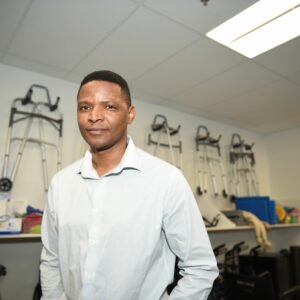
Factors associated with cardiorespiratory fitness in 9–17-year-old children and adolescents in Zimbabwe
Abstract Overview
Background: Cardiorespiratory fitness (CRF) in childhood and adolescence is linked with future cardiovascular health. Several sociodemographic and other factors may influence childhood and adolescent CRF.
Purpose: To assess factors associated with CRF in Zimbabwean school children and adolescents.
Methods: This was a cross-sectional study in which participants were recruited from 20 administrative districts across all 10 provinces in Zimbabwe. Parental consent and child/adolescent assent were obtained before participants completed a self-administered questionnaire which collected socio-demographic and other relevant data. We measured cardiorespiratory fitness (CRF) using the 20-meter shuttle run test and the Leger equation to estimate Vo2max. A multilevel mixed-effects model (SAS PROC MIXED) accounting for clustering at the provincial level was used to determine factors associated with participants’ VO2max. Statistical analyses were performed in SAS 9.4 with the alpha level set at 0.05.
Results: The average age (sample n= 1163; 54% female) was 12 ± 0.95 years. Mean estimated VO2max for the whole sample was 46.6 ± 4.8 mL/kg/min. Males had significantly higher Vo2max compared to females (t=9.9; p<.0001). Attending boarding schools (t=-3.0; p=0.003) was associated with lower vo2max compared to day schools. Rural residence was associated with higher Vo2max compared to living in urban areas (t=7.4; p<.0001). The largest proportions of total variance in Vo2max occurred at the individual (95.0%) and provincial (5.0%) levels. Lower BMI, low socioeconomic status, younger age, attending day school, rural residence, active school commute, and male sex, were significantly associated with higher Vo2max.
Conclusions: Several factors beyond the individual child or adolescent, including family, community and geographic, were independently associated with CRF, suggesting the need to consider the socioecological model in intervention design.
Practical Implications: Childhood and adolescent physical activity programs promoting CRF should specifically target females, boarding schools, and urbanites.
Funding: Government of Zimbabwe under the Ministry of Primary and Secondary Education.
Additional Authors
Name: Khanyile Dlamini
Affiliation: Department of Sport Science and Coaching, National University of Science and Technology, Bulawayo, Zimbabwe
Presenting Author: no
Name: Daga Makaza
Affiliation: Department of Sport Science and Coaching, National University of Science and Technology, Bulawayo, Zimbabwe
Presenting Author: no
Name: Anesuishe Madondo
Affiliation: Department of Physiotherapy, National Star College, Cheltenham, Gloucestershire, United Kingdom
Presenting Author: no
Name: Paul Makoni
Affiliation: Research and Internationalization Office, National University of Science and Technology, Bulawayo, Zimbabwe
Presenting Author: no
Name: Stonard Mapfumo
Affiliation: Curriculum Development and Technical Services, Ministry of Primary and Secondary Education, Harare, Zimbabwe
Presenting Author: no
Name: Dzikamayi Mandaza
Affiliation: Curriculum Development and Technical Services, Ministry of Primary and Secondary Education, Harare, Zimbabwe
Presenting Author: no
Name: Tonderayi Matsungo
Affiliation: Department of Nutrition, Dietetics and Food Sciences, University of Zimbabwe, Harare, Zimbabwe
Presenting Author: no

